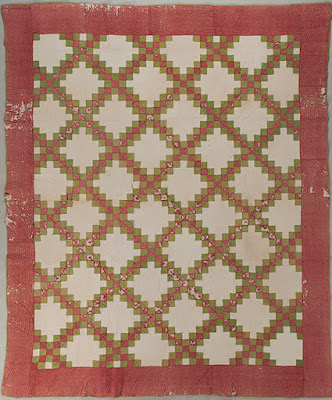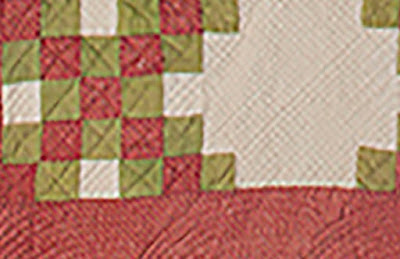A quilt that is difficult to date.
84" x 97"
The quilt is in the collection of the Museum of Early Southern Decorative Arts
(MESDA), attributed to Amelia Arnold Hightower Holt Calhoun (1811-1889) of Georgia.
The museum caption indicates it was made between 1830 and 1850. The donor, a descendant of Amelia's sister Elizabeth Leggett Hightower White (1816-1886), gave the name as Double Chain.
James Montgomery Calhoun (1811-1875)
While Amelia Calhoun's Civil War experiences are not well documented, those of her second husband
James M. Calhoun's are. He was the wartime Mayor of Atlanta, one of the committee of men who surrendered the city to General William T. Sherman in 1864 after weeks of shelling and the retreat of Confederates led by General John Bell Hood.
Library of Congress
Atlanta in 1864, photographed by
George Barnard after surrender.
When the Civil War began in April, 1861 Amelia had been married to James for just a few months. At their December, 1860 marriage she was a widow of about 50 with no living children; he a widower the same age with at least two daughters and two grown sons. Amelia's first husband Tarpley Tillman P. Holt (1808- 1854) had died in Upson County a few years earlier.
The 1850 census shows Tarply Holt with 8 slaves, most
of them children.
That year Amelia at 35 is living with her husband, a modest farmer in Upson County,
and two teen-aged daughters. Only Amelia would survive the decade.
Tombstone of daughter Caroline Holt Richardson (1833-1853) in
the Hightower family cemetery in Upson County. Caroline had
been married two years at the time of her death.
1860 tax records show the widowed Amelia with considerable assets: real
estate worth $2,500 and other property worth nearly $44,000,
probably the value of the enslaved people.
That wealth did not survive the 1860s.
Calhoun/Holt marriage record
James Calhoun's first wife Emma Eliza Dabney Calhoun (1810 – 1860) had died in February, the year of his second marriage. James was a lawyer and a politician, not very successful at politics before the war as he was a Whig in the Democrat-voting state of Georgia.
From his obituary
John Caldwell Calhoun (1782-1850)
was a leading advocate of slavery and states' rights,
inspiring political sentiments that led to the war ten
years after his death.
His father William's cousin, fire-eating Democrat John C. Calhoun, advised him to switch parties but James's Whig principles would not be compromised. Whigs were in favor of spending money on what we'd call infrastructure, rather inconsistently opposed to the economic system of slavery and its expansion into new territories and strongly in favor of the national union and an active central government. Tariff taxes on imported goods to support Northern industries infuriated the South.
James was considered a moderate and a Unionist in a Secession-determined city. But once the war began and the ranks of Democrats thinned to join the Confederate army James won enough mayoral votes to be elected to 4 one-year terms from 1862 through 1866.
Atlanta burning from Harpers Weekly
Confederate transportation hub Atlanta became Sherman's target in 1864. James and a committee of city leaders found Union Colonel John Coburn marching into town on Marietta Street on September 1st and formally handed over the city.
The Mayor recalled saying: "Colonel Coburn, the fortune of war has placed Atlanta in your hands. As Mayor of the City I come to ask your protection for noncombatants and for private property."
Sherman shocked Atlanta by declaring that all civilians must evacuate the city. Neither noncombatants nor private property would be spared. The Mayor wrote asking for mercy but Sherman refused to change his orders. All civilians must leave. In the reply he made his famous (and wrongly quoted) "War is Hell" comment. "War is cruelty" were his words.
Leaving Atlanta, Harpers Weekly
After the peace in the spring of 1865 Atlantans returned to rebuild the city. There was money to be made and James prospered. The 1870 census found them living in Atlanta with 20-year-old Black servant Henrietta who may have been one of the children recorded 10 years earlier. After James Calhoun died in November, 1875 Amelia moved back to Thomaston.
The 1880 census lists her in Thomaston living with a boarder.
Thomaston about 20 years after Amelia's death there in 1889.
Members of the Hightower family founded the Thomaston Mills
at the end of the 19th century.
Back to the mysteries of the quilt....
From the caption: "This quilt was given by the maker, Amelia Hightower Holt Calhoun, to her sister, Elizabeth Leggett Hightower White (1816-1886). Elizabeth gave the quilt to her grandson, John White Gardner (1857-1936) and he to his daughter, Mildred Gardner Kelley (b.1892). Mildred gave the quilt to her sister, Priscilla Neal Gardner Hamrick (d.1962), who was the grandmother of the donor."If Amelia made this quilt she would have done so between 1840 and the late 1880s. The family tale: She gave it to her sister Elizabeth Leggett Hightower (1816-1886) who died a few years before Amelia. Elizabeth married twice. Her first husband was John Martin White (1806-1850); the second Allen Gates Fambro (1800-1880). Elizabeth had children with both husbands. The quilt went to John White Gardner (1857-1936), son of her eldest daughter Mary Antoinette White Gardner (1835-1912). John White Gardner went west and presumably so did the quilt. Next in line was his daughter, Mildred Gardner Kelley (1892-1976), born in Texas, died in Missouri.
After Mildred the chain is confused. Notes say it went next to Mildred's sister Priscilla Neal Gardner Hamrick (1866-1962) born in Tennessee. But Priscilla is Mildred's aunt. The quilt then went to Priscilla's grandson Ralph Anderson Brown, son of Priscilla's daughter Gertrude Hamrick Brown (1896-1951) who was back in Georgia. Ralph A. Brown donated the quilt and the story.
Similar Double Irish Chain quilt dated 1881
from the North Carolina project & the Quilt Index.
The chain of ownership shows some impressive family record keeping with only one link not corroborated. The well-worn quilt must have warmed many family members. On the other hand six owners from Amelia to her great-great-etc. grand nephew may have been mostly accurate about genealogy but not the quilt's origins.
The inscription on the North Carolina quilt: "Jak Tucker/1881"
Without examining it in the cloth I'd be inclined to date the quilt as last quarter of the 19th century. Amelia Hightower Holt Calhoun may have made it later in life but it remains a link to important events in Georgia's history.
























2 comments:
Such interesting history! I appreciate all the research you did to find these many and varied family members and their stories. What fun family research is! And I do love double Irish chains. I have made 5 over the years, and will at last make a red and white one this summer.
Barbara, Love all this history and you have done it again. Another relative: Amelia Arnold Hightower (Holt, Calhoun) is my 2nd cousin, 5x removed. My mother (92 years old and going strong) is a Hightower. She will be fascinated with this. She and I are both quilters but have never seen or heard of this story. Amelia's great-grandfather is William Calvin Hightower who married Susannah Hanks. That Hanks line leads to Nancy Hanks Lincoln and dear President Abe Lincoln (my 4th cousin, 5x removed.)
Post a Comment